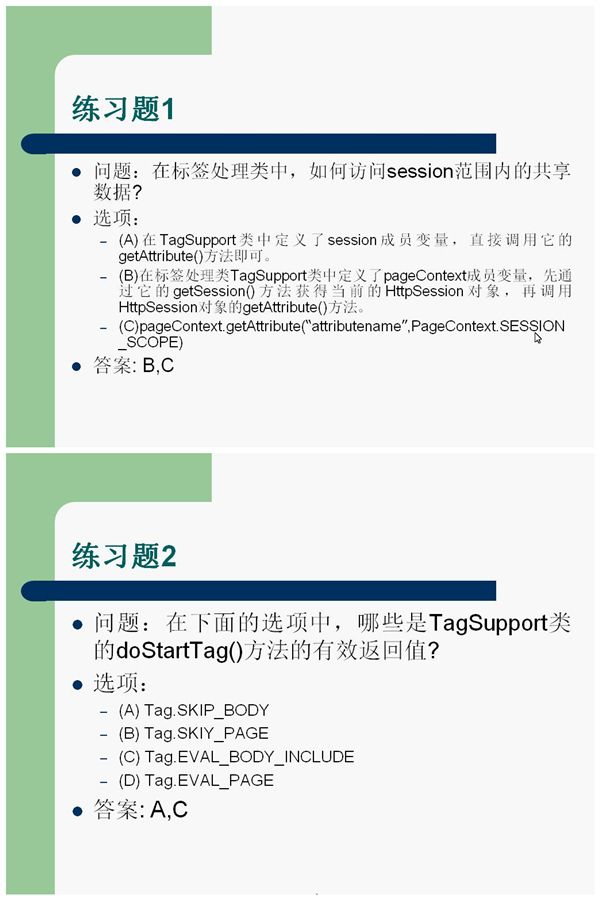第八部分_客户化JSP标签
EL语言(减少JSP页面中的Java代码)

<body>
<%String username = request.getParameter("username");
String password = request.getParameter("password");
%>
username: <% out.print(username); %><br>
password: <% out.print(password); %><br>
username: ${param.username }<br> <%用EL达到和上面四行代码同样的功能 %>
password: ${param.password }<br>
</body>

属性范围->在EL中的名称
Page->pageScope;Request->requestScope;Session->sessionScope;Application->applicationScope.

此外,启动tomcat服务器,在浏览器中访问localhost:8080/examples,选择JSP Examples,其中给出了若干实例,也可以进行相关的学习。

首先创建标签处理类HelloTag.java:
package com.jsp.tag;
import javax.servlet.jsp.JspException;
import javax.servlet.jsp.JspTagException;
import javax.servlet.jsp.tagext.TagSupport;
public class HelloTag extends TagSupport
{
public HelloTag()
{
}
public int doStartTag() throws JspException
{
try
{
this.pageContext.getOut().print("nihao");
}
catch (Exception ex)
{
throw new JspTagException(ex.getMessage());
}
return EVAL_BODY_INCLUDE;
}
// Method called when the closing hello tag is encountered
public int doEndTag() throws JspException
{
try
{
// We use the pageContext to get a Writer
// We then print the text string Hello
this.pageContext.getOut().print("Hello");
}
catch (Exception e)
{
throw new JspTagException(e.getMessage());
}
return EVAL_PAGE;
}
public void release()
{
// Call the parent's release to release any resources
// used by the parent tag.
// This is just good practice for when you start creating
// hierarchies of tags.
super.release();
}
}
然后,创建标签库描述文件(在WEB-INF下新建一个tld(taglib description )文件,这里命名为mytaglib.tld):
<?xml version="1.0" encoding="ISO-8859-1" ?>
<!DOCTYPE taglib
PUBLIC "-//Sun Microsystems, Inc.//DTD JSP Tag Library 1.1//EN"
"http://java.sun.com/j2ee/dtds/web-jsptaglibrary_1_1.dtd">
<!-- a tag library descriptor -->
<taglib>
<tlibversion>1.0</tlibversion>
<jspversion>1.1</jspversion>
<shortname>mytaglib</shortname>
<uri>/mytaglib</uri>
<tag>
<name>hello</name>
<tagclass>com.jsp.tag.HelloTag</tagclass>
<bodycontent>empty</bodycontent>
</tag>
</taglib>
然后,在hellowithtag1.jsp中引入标签库,然后插入标签:
<%@ taglib uri="/mytaglib" prefix="mm" %> <html> <head> <title>tag library example</title> </head> <body> <b><mm:hello/></b> </body> </html>
访问http://localhost:8080/test/hellowithtag1.jsp,输出nihaoHello
范例2:
创建一个能替换test应用中JSP网页的静态文本的标签,这个标签名为message,它放在mytaglib标签库中。
首先在WEB-INF下面放置一个静态文本messageresource.properties
hello.title = Tile of hello.jsp hello.hello = Hello
然后通过一个DispatcherServlet装载:
package com.test.servlet;
import java.io.InputStream;
import java.util.Properties;
import javax.servlet.ServletConfig;
import javax.servlet.ServletContext;
import javax.servlet.ServletException;
import javax.servlet.http.HttpServlet;
public class DispatcherServlet extends HttpServlet
{
public void init(ServletConfig config) throws ServletException
{
super.init(config);
Properties ps = new Properties();
try
{
ServletContext context = config.getServletContext();
InputStream in = context
.getResourceAsStream("/WEB-INF/messageresource.properties");
ps.load(in);
in.close();
context.setAttribute("ps", ps);
}
catch (Exception e)
{
e.printStackTrace();
}
}
public void destroy()
{
}
}
接下来,是标签库的处理类MessageTag.java:
package com.jsp.tag;
import java.util.Properties;
import javax.servlet.jsp.JspException;
import javax.servlet.jsp.JspTagException;
import javax.servlet.jsp.PageContext;
import javax.servlet.jsp.tagext.TagSupport;
public class MessageTag extends TagSupport
{
private String key = null;
public MessageTag()
{
}
public String getKey()
{
return this.key;
}
public void setKey(String key)
{
this.key = key;
}
// Method called when the closing hello tag is encountered
public int doEndTag() throws JspException
{
try
{
Properties ps = (Properties) pageContext.getAttribute("ps",
PageContext.APPLICATION_SCOPE);
String message = (String) ps.get(key);
pageContext.getOut().print(message);
}
catch (Exception e)
{
throw new JspTagException(e.getMessage());
}
return EVAL_PAGE;
}
public void release()
{
super.release();
}
}
添加相关信息到标签库描述文件mytaglib.tld中:
<?xml version="1.0" encoding="ISO-8859-1" ?>
<!DOCTYPE taglib
PUBLIC "-//Sun Microsystems, Inc.//DTD JSP Tag Library 1.1//EN"
"http://java.sun.com/j2ee/dtds/web-jsptaglibrary_1_1.dtd">
<!-- a tag library descriptor -->
<taglib>
<tlibversion>1.0</tlibversion>
<jspversion>1.1</jspversion>
<shortname>mytaglib</shortname>
<uri>/mytaglib</uri>
<tag>
<name>hello</name>
<tagclass>com.jsp.tag.HelloTag</tagclass>
<bodycontent>empty</bodycontent>
</tag>
<tag>
<name>message</name>
<tagclass>com.jsp.tag.MessageTag</tagclass>
<bodycontent>empty</bodycontent>
<attribute>
<name>key</name>
<required>true</required>
</attribute>
</tag>
</taglib>
最后,在hellowithtag2.jsp文件中引入标签库,然后插入标签:
<%@ page contentType="text/html; charset=GB2312" %> <%@ taglib uri="/mytaglib" prefix="mm" %> <html> <head> <title><mm:message key="hello.title"/></title> </head> <body> <b><mm:message key="hello.hello"/></b> </body> </html>
为了在web应用启动时通过DispatcherServlet装载静态文本,应该在web.xml中配置这个Servlet时设置load-on-startup属性:
<servlet>
<servlet-name>DispatcherServlet</servlet-name>
<servlet-class>com.test.servlet.DispatcherServlet</servlet-class>
<load-on-startup>5</load-on-startup>
</servlet>
在MessageTag的doEndTag方法中,首先从pageContext中读取包含静态文本的Properties对象:
public int doEndTag() throws JspException
{
try
{
Properties ps = (Properties) pageContext.getAttribute("ps",
PageContext.APPLICATION_SCOPE);
String message = (String) ps.get(key);
pageContext.getOut().print(message);
}
catch (Exception e)
{
throw new JspTagException(e.getMessage());
}
return EVAL_PAGE;
}
然后从Properties对象中读取key对应的静态文本,最后输出该文本。
最后,访问http://localhost:8080/test/hellowithtag2.jsp,输出hello。
